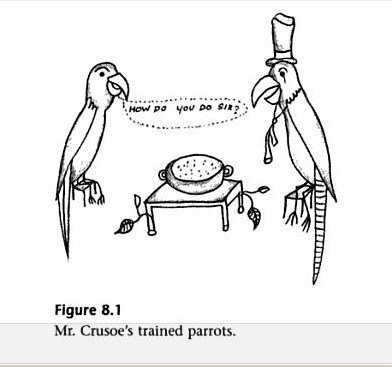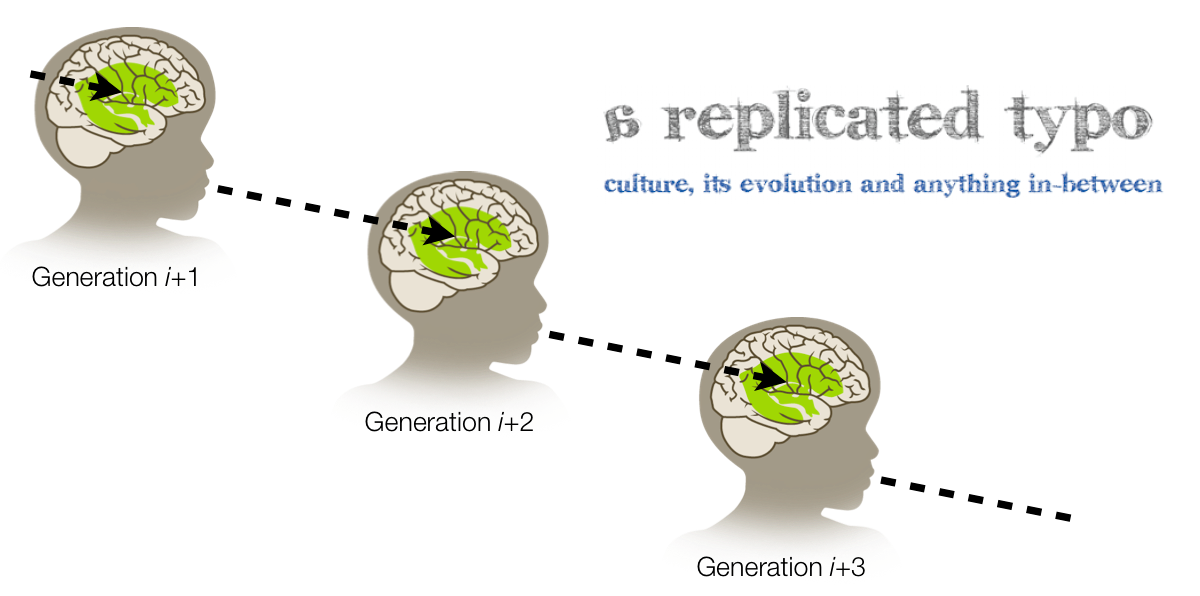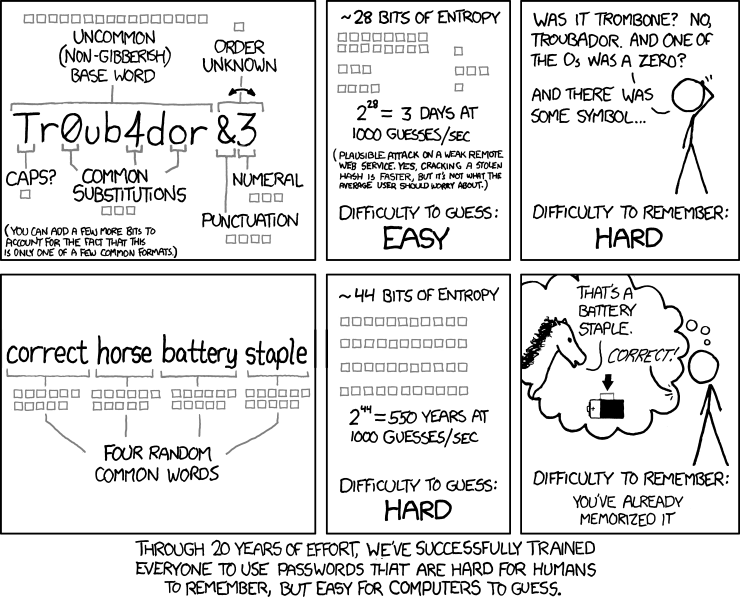When asked to name a linguistically diverse place, I would have said Papua New Guinea, and if asked to name a stereotypically monolingual country, I would have named the USA. However, this recent report from the New York Times suggests that, due to its large immigrant population, New York harbours more endangered languages than anywhere else on Earth (tipped off from Edinburgh University’s Lang Soc Blog). From a field linguists’ point of view this may make discovery of and access to minority languages much easier (although may mean the end of exotic holidays). From a cultural evolution point of view, a more global community may mean a radically different kind of competition between languages. Nice video below:
Mr Crusoe’s Trained Parrots
In the magazine section on the BBC news website today is a feature on wild parrots picking up phrases from domesticated birds.
The article begins:
Wild parrots in Australia are apparently picking up phrases from escapee pet cockatoos who join their flocks. Why – and how – can some birds talk?
Those strolling in Sydney’s parks are being startled by squawks of “Hello darling!” and “What’s happening?” from the trees.
Wild birds such as galahs, sulphur-crested cockatoos and corellas are repeating phrases passed on by domesticated counterparts that escaped or were released, says naturalist Martyn Robinson, of Sydney’s Australian Museum.
The museum has received numerous reports of talkative wild birds from startled members of the public.
You can continue reading the article here http://www.bbc.co.uk/news/magazine-14930062. It talks a bit about how parrots can produce human like sounds but I posted the story here because I found it interesting that wild birds would pick up human phrases through social learning and wondered how far these phrases could go through a process of cultural transmission.

It reminded me of this figure from Eva Jablonka and Marion J. Lamb’s book “Evolution in four dimensions: genetic, epigenetic, behavioral, and symbolic” inspired by a story by Spalding (1876). The story tells of Robinson Crusoe landing on his island and teaching 2 parrots the phrase “how do you do sir?”. He continues to teach the phrase to the offspring of these parrots for some generations. Crusoe then (because he’s on a dessert island and he’s bored) breeds the parrots who say “how do you do sir?” the best. After a while the young parrots start to repeat the phrase so early it is not known if it is learned behaviour or instinct. It is found to have become instinct because Crusoe selected for the best learners and the parrots will presumably continue this behaviour long after Crusoe has died. Spalding then hypothesises that should the parrots acquire a taste for good English this behaviour should continue to be selected through sexual selection. Taking figure 8.1 at face value it seems the parrots are also selected for fine taste in hats and ability to sit properly on chairs.
Should Mother Tongue be Father Tongue?
A new paper, published in Science last week, has reviewed some of the correlations which suggest that language change may be subject to sex-specific transmission. This has been discovered through looking at Y-chromosome DNA types. Modern male DNA (Y-Chromosome) is found to be the DNA from the population who originally spoke the language which has survived, whereas modern female DNA is often not the DNA of the population which spoke the language which has survived.
This evidence has come from, among others, a study by Chaubey (2011) with evidence for the Indian subcontinent. Austroasiatic languages are spoken by tribes with a high proportion of immigrant Y-chromosome DNA from East Asia, but with a high percentage of local female (mitochondrial) DNA. This pattern was also true of the Tibeto-Burman language family in northeastern India.
Other studies found matching correlations in Africa and found that Niger-Congo languages correlate with Y-Chromosome types, but the female DNA, which correlated more with geography (Wood et al. (2005) and de Filippo et al. (2011)).
Sex-biased language change can also be seen in the expansion of the Malayo-Polynesians in New Guinea. New Guinea has populations of Malayo-Polynesian speakers and also populations of Melanesian speakers. Malayo-Polynesian female DNA is about the same in both Malayo-Polynesian speaking areas and Melanesian speaking areas. However, the Malayo-Polynesian Y-Chromosome is found way more in the Malayo-Polynesian speaking areas than the Melanesian speaking areas.
This pattern is also seen in Iceland where the female DNA is mainly British, but the Y-chromosome is mainly Scandinavian. This follows the pattern because the Icelandic language is also Scandinavian.
Forster and Renfrew (authors of the Science paper) show that these findings complement studies such as Stoneking and Delfin who found that in East Asia, it is women who move after marriage rather than men. This means that if a man and woman migrate to a populated area their female offspring will move to other villages when married but their male offspring will remain static meaning that their language will stay in the same place as their Y-Chromosomes.
Is this the only mechanism at work when correlations of sex-specific language change can be seen? Others have hypothesized things such as farming and trade might be a factor. Groups of emigrating agriculturalists may also contribute where men outnumber women and take wives from the local community they were moving to. Men are also biologically capable of passing on and spreading about much more of their DNA than women can. It may also be the case that it is the father’s language rather than the mother’s which will be dominant within a family but I think more research would have to be done on this.
Interestingly the opposite correlation to the ones seen above is seen in Greenland where both the language and female DNA is Eskimo but the Y-Chromosome DNA is European.
Compositionality and Bilingualism
Last week I put up a link to an online experiment. Here’s the results! You can still do the experiment first, if you like, here. Source code and raw results at the bottom.
Languages evolve over time under a pressure to be learned by a new generation. Does learning two languages at once effect this pressure? My experiment says … maybe.
These pressures include ones for learnability (compression) and expressivity (able to express a large variety of meanings, Kirby, Cornish & Smith, 2008). Bilingualism seems like an unlikely ability since learning an extra language leaves the speaker potentially no more expressive at a cost of an increase in the amount of effort required to learn it. There is no pressure for one language structure (e.g. English) to adapt to another language (e.g. Mandarin) so that they can become optimally learnable and expressive as a single medium. That is, there’s no reason to assume that expressivity and learnability pressures apply across languages (which are not being used by the same people).
Nevertheless, children display an aptitude and a willingness to learn and use multiple languages simultaneously, and at a similar rate to monolingual children. Therefore, languages do seem to have adapted to be learnable simultaneously. Does the compatibility of languages point to a strong innate property of language? In contrast, it might point to underlying similarity in the structure of languages, brought about by universal principles of communication.
Researching Social Biases: Lessons for Science Communication and Blogging
Mesoudi, Whiten and Dunbar showed in a study in 2006 that humans are much more likely to remember facts if they are presented in a social narrative. The study used a diffusion chain paradigm whereby a number of stories, some with more social elements in them than others, were read by a participant who then had to replicate the stories as best they could from memory. Their output was then fed to the next participant who did the same and this was repeated for four generations. The results of this experiment showed that stories with a large amount of social relationships were passed on with much great accuracy than more non-social, fact-based stories.
Recently I visited the newly refurbished National Museum of Scotland and as part of the new “Earth in Space” exhibit they had a movie which was all about the universe. Now, the universe is not a place with very many social problems. Stars, planets and galaxies are not social entities. They are governed by the rules of physics and who’s friends with who doesn’t come into it. This creates a problem for any science communicator as how can you get your visitors to go any knowing a little bit more about our universe than they did before simply by throwing facts at them. We can see from Mesoudi et al.’s study that humans are no good at remembering information about non-social entities. The Museum stepped up to this problem though and told the story of the universe through the narrative of two children who were exploring the universe in a museum setting of their own.
It isn’t only in museum settings that knowledge of humans’ cognitive biases can be useful. Recently the Wellcome Trust in combination with the Guardian had a Science Writing Competition. Unfortunately the deadline for entries has gone but all of the information about what makes good Science writing is still available of the website here. This included an article by Gaia Vince about how good science writing needs a good narrative structure. The article encourages science writers to not only report the science but look at how that science affects the lives of the readers and, in doing so, introducing social elements into the story.
New ideas are also surfacing that it might pay to go even further and fictionalise the research that you’re wanting to communicate and turn it into a fantastical story. Diamond Light Source, a huge particle accelerator in the Oxfordshire countryside, have got an amazing idea. As a public engagement exercise they’ve set up a short story writing competition called “Light Reading”. This is not only a public engagement activity in itself but the anthology of stories which will be generated from this competition will go some way to engaging the public as well with stories that will really make them remember what it is that the Diamond Light Source research. A stroke of public engagement genius and a really good example of how studying things such as social biases can lead to more successfully engagement and science writing, and with that, blogging.
You can view the competition’s website, and perhaps even enter your own story!
References
The Language Evolution Tree: Yet more evidence
The Speculative Grammarian has published startling new findings that the Acacia Tree is central to Language Evolution. This ground-breaking work was based on my post here.
Happy EvoLang deadline day!
Sean Geraint (2011). Language Evolution and the Acacia Tree Speculative Grammarian, Vol CLXII (4)
Fun language evolution experiment!
Do a fun language experiment!*
You can take part in a pilot experiment about language learning: It takes about 8 minutes (and is NOT an iterated learning experiment, although it looks a bit like one). I’ll release the results (and the hypothesis) right here on Replicated Typo.
* may not be loads of fun.
A spin glass model of cultural consensus
Does your social network determine your rational rationality? When trying to co-ordinate with a number of other people on a cultural feature, the locally rational thing to do is to go with the majority. However, in certain situations it might make sense to choose the minority feature. This means that learning multiple features might be rational in some situations, even if there is a pressure against redundancy. I’m interested in whether there are situations in which it is rational to be bilingual and whether bilingualism is stable over long periods of time. Previous models suggest that bilingualism is not stable (e.g. Castello et al. 2007), therefore an irrational strategy (at least not a primary strategy), but these were based on locally rational learners.
This week we had a lecture from Simon DeDeo on system-wide timescales in the behaviour of macaques. He talked about Spin Glasses and rationality, which got me thinking. A Spin Glass is a kind of magnetised material where the ‘spin’ or magnetism (plus or minus) of the molecules does not reach a consensus, but flips about chaotically. This happens when the structure of the material creates ‘frustrated’ triangles where a molecule is trying to co-ordinate with other molecules with opposing spins, making it difficult to resolve the tensions. Long chains of interconnected frustrated triangles can cause system-wide flips on the order of hours or days and are difficult to study both in models (Ising model) and in the real world.
Language Evolves in R, not Python: An apology
One of the risks of blogging is that you can fire off ideas into the public domain while you’re still excited about them and haven’t really tested them all that well. Last month I blogged about a random walk model of linguistic complexity (the current post won’t make much sense unless you’ve read the original). Essentially, it was trying to find a baseline for the expected correlation between a population’s size and a measure of linguistic complexity. It assumed that the rate of change in the linguistic measure was linked to population size. Somewhat surprisingly, correlations between the two measures (similar to the kind described in Lupyan & Dale, 2010) emerged, despite there being no directional link.
However, these observations were made on the basis of a relatively small sample size. In order to discover why the model was behaving like this, I needed to run a lot more tests. The model was running slowly in python, so I transliterated it to R. When I did, the results were very different: In the first model an inverse relationship between the population size and the rate of change of linguistic complexity yielded a negative correlation between population size and linguistic complexity (perhaps explaining results such as Lupyan & Dale’s). However in the R model this did not occur. In fact, significant correlations only appeared 5% of the time, with that 5% being split exactly between positive and negative correlations. That is, the baseline model has a standard confidence interval, not the much stricter one I had suggested in the last post.
Why was this happening? In short: Rounding errors and small sample sizes.
I checked the Python code, but couldn’t find a bug, so the correlations really were appearing, and really were favouring a negative correlation. Here’s my best explanation: First, the sample of runs was too low to capture the proper distribution. However, strong correlations were appearing. This could be because although the linguistic complexity measure started out pretty randomly distributed, the individual communities were synchronising at the maximum and minimum of the range as they bumped up against it. This caused temporary clusters in the low ranges where the linguistic complexity was changing rapidly (and therefore more likely to synchronise), creating tied ranks in the corners. In addition to this, the Python script I was using had a lower bit depth for its numbers than R, so was more prone to rounding errors. I have to assume as well that my Python script somehow favoured numbers closer to 1 than to 0. It’s still not a very satisfactory explanation, but the conclusion remains that, as one would expect, affecting just the rate of change of linguistic complexity does not produce correlations.
Modelling evolutionary systems often runs into these kinds of problems: The search spaces are often intractable for some approaches. Also I am not, as a mere linguist, aware of some of the more advanced computational techniques. It’s one of the reasons that Evolutionary Linguistics requires a pluralist approach and tools from many different disciplines.
It’s embarrassing to have to correct previous statements, but I guess that’s what Science is about. In the blogging age ideas can get out before they’re fully tested and potentially affect other work. This has its advantages – good ideas can get out faster. But it also means that the reader must be more critical in order to catch poor ideas like the one I’m correcting here.
Sorry, Science.
Here’s a link to the R script (25 lines of code!).
Lupyan G, & Dale R (2010). Language structure is partly determined by social structure. PloS one, 5 (1) PMID: 20098492
Passwords adapt to hacking technology
One of this week’s xkcd comics makes the point that combinatorial passwords (sequence of common words) may be better than holistic ones (semi-random string). This may be because we’re fooled into thinking that a password that is difficult to remember will be difficult to guess. This turns out not to be the case. I’m currently thinking about whether combinatoriality would emerge from an iterated learning chain even if the participants were told to give answers that they thought nobody else would give.

